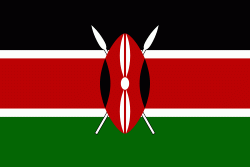Marakwet District (Elegeyo-Marakwet)
Marakwet District is a defunct administrative district in the former Rift Valley Province of Kenya. Its capital town was Kapsowar. The district had a population of 140.629. Local people are predominantly of the Marakwet tribe.
The district was created in 1927 as Elgeyo/Marakwet District. It was split into Marakwet and Keiyo Districts in 1994. In 2010, the two districts were joined again to form Elgeyo-Marakwet County.
Many famous Kenyan runners come from Marakwet, most notably Moses Kiptanui, Evans Rutto, Reuben Kosgei, Ezekiel Kemboi and Richard Chelimo.
The district has only one local authority, Marakwet county council. Its population is thus same as the district (140,629). The council and district has no population classified as urban (1999 census ).
The Marakwet district headquarters was located at the hilly town of Kapsowar. Other rural centres/towns are Chebiemit, Kapcherop, Cheptongei, Arroor, Chesongoch, Chesoi, Kipsaiya, Sisiya, Kapyego, Tot, Sangach, Kapchebau, Kakimiti, Meuno, Kamogo, Tirap, and Embobut Mosop.
The district was created in 1927 as Elgeyo/Marakwet District. It was split into Marakwet and Keiyo Districts in 1994. In 2010, the two districts were joined again to form Elgeyo-Marakwet County.
Many famous Kenyan runners come from Marakwet, most notably Moses Kiptanui, Evans Rutto, Reuben Kosgei, Ezekiel Kemboi and Richard Chelimo.
The district has only one local authority, Marakwet county council. Its population is thus same as the district (140,629). The council and district has no population classified as urban (1999 census ).
The Marakwet district headquarters was located at the hilly town of Kapsowar. Other rural centres/towns are Chebiemit, Kapcherop, Cheptongei, Arroor, Chesongoch, Chesoi, Kipsaiya, Sisiya, Kapyego, Tot, Sangach, Kapchebau, Kakimiti, Meuno, Kamogo, Tirap, and Embobut Mosop.
Map - Marakwet District (Elegeyo-Marakwet)
Map
Country - Kenya
 |
 |
| Flag of Kenya | |
Kenya's earliest inhabitants were hunter-gatherers, like the present-day Hadza people. According to archaeological dating of associated artifacts and skeletal material, Cushitic speakers first settled in Kenya's lowlands between 3,200 and 1,300 BC, a phase known as the Lowland Savanna Pastoral Neolithic. Nilotic-speaking pastoralists (ancestral to Kenya's Nilotic speakers) began migrating from present-day South Sudan into Kenya around 500 BC. Bantu people settled at the coast and the interior between 250 BC and 500 AD. European contact began in 1500 AD with the Portuguese Empire, and effective colonisation of Kenya began in the 19th century during the European exploration of the interior. Modern-day Kenya emerged from a protectorate established by the British Empire in 1895 and the subsequent Kenya Colony, which began in 1920. Numerous disputes between the UK and the colony led to the Mau Mau revolution, which began in 1952, and the declaration of independence in 1963. After independence, Kenya remained a member of the Commonwealth of Nations. The current constitution was adopted in 2010 and replaced the 1963 independence constitution.
Currency / Language
| ISO | Currency | Symbol | Significant figures |
|---|---|---|---|
| KES | Kenyan shilling | Sh | 2 |
| ISO | Language |
|---|---|
| EN | English language |
| SW | Swahili language |















